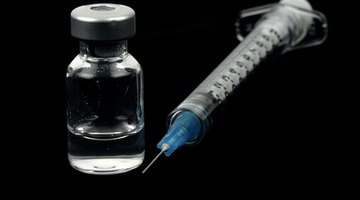How to Sterilize Vials
Sterilizing is an important step in controlling bacterial growth. It can be accomplished by raising temperatures high enough to kill bacteria, by irradiating the object, or with autoclaves.

Things You Will Need
- Glass vials and stoppers
- Pot
- Lid
- Metal tongs
- Sterile cotton balls
- Rubbing alcohol
- Clean towel
Tip
Always use metal tongs instead of plastic. Plastic tongs are porous and can leach harmful chemicals when exposed to heat.
Warning
Be aware that heat sterilization can only kill what is on the surface of the glass vial at the time. It will not protect the vials from contamination from bacteria in the outside air once you take them from the bath.
Since glass is nonporous and bacteria cannot burrow into its surface, glass vials are easier to sterilize than objects made of other, porous materials. If you don't have an autoclave, you can sterilize glass vials effectively with one simple procedure. Keep in mind that this method does not work on plastic vials, which should be discarded after a single use.
-
Fill a clean pot or saucepan with water. Set it on the stove and turn the burner on high.
-
Wait for the water to come to a rolling boil. Place the glass vials and stoppers into the water. Cover the pot with its lid. Leave the water boiling for 10 minutes. Turn the burner off.
-
Set out a clean towel on the counter. Moisten sterile cotton balls with rubbing alcohol and wipe the surfaces of the tongs.
-
Remove the lid from the pot. Reach in with the tongs and secure each vial and stopper, setting them right-side up on the clean towel to air dry. Replace stoppers in vials when cool.
References
Photo Credits
- drug vial and syringe image by William Berry from Fotolia.com
- drug vial and syringe image by William Berry from Fotolia.com
More Articles



